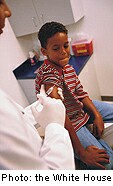
FRIDAY, Sept. 3 (HealthDay News) — Children with sickle cell disease experience more life-threatening complications from the H1N1 swine flu than from seasonal flu, a new study has found.
This means that doctors and parents need to be aware that children with sickle cell disease are more likely to need emergency treatment and to be hospitalized, Dr. John Strouse of Johns Hopkins Children’s Center and colleagues explained in a Hopkins news release.
The study authors analyzed the medical records of 123 children with sickle cell disease treated for any kind of flu between September 1993 and December 2009. Of those, 29 were infected with the 2009 H1N1 swine flu virus.
Both seasonal flu and the H1N1 virus caused typical flu symptoms, such as fever, cough and a runny nose, in most of the children. However, those infected with H1N1 were nearly three times more likely to develop acute chest syndrome, a leading cause of death in children with sickle cell disease. It is marked by lung inflammation, reduced ability to absorb oxygen and shortness of breath.
In addition, compared to children with seasonal flu, H1N1-infected children had a more than five-times increased risk of ending up in the intensive care unit, and were more likely to require a ventilator for breathing.
The study, released online in advance of publication in an upcoming print issue of the journal Blood, underscores the need for vaccination against the H1N1 and the seasonal flu strains, the researchers said.
Sickle cell disease, an inherited disorder characterized by abnormally shaped blood cells, affects about 100,000 people in the United States, mostly black Americans. An earlier study from Hopkins Children’s Center showed that children with sickle cell disease are hospitalized with seasonal flu nearly 80 times more often than other youngsters.
More information
The Nemours Foundation has more about sickle cell disease.

